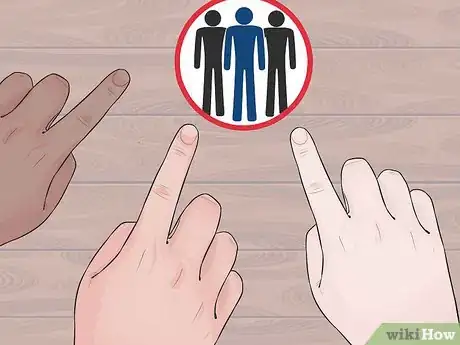This article was co-authored by Patrick Muñoz. Patrick is an internationally recognized Voice & Speech Coach, focusing on public speaking, vocal power, accent and dialects, accent reduction, voiceover, acting and speech therapy. He has worked with clients such as Penelope Cruz, Eva Longoria, and Roselyn Sanchez. He was voted LA's Favorite Voice and Dialect Coach by BACKSTAGE, is the voice and speech coach for Disney and Turner Classic Movies, and is a member of Voice and Speech Trainers Association.
wikiHow marks an article as reader-approved once it receives enough positive feedback. In this case, several readers have written to tell us that this article was helpful to them, earning it our reader-approved status.
This article has been viewed 122,667 times.
A short preparation debate is a kind of debate where two teams are given a topic upon arrival and must prepare presentations within a time limit. The debate teams usually have between 30 and 90 minutes to prepare their speeches. In most cases, teams are given 60 minutes to prepare. Short preparation debates are similar to traditional debates in terms of strategy and delivery. The key difference is that there is a time limit on preparation. [1]
Steps
Developing a Case Together
-
1Designate a team leader. The team leader will make final decisions about definitions or arguments should there be disagreement in the group. He or she will also keep track of time to ensure that preparation is moving efficiently.
- This method requires you to work alone first, discuss as a group, and then work independently again. Decide if this is the right method for your team and topic.
-
2Analyze the topic or resolution (five minutes). Individually brainstorm the development of your team's argument.
- If your topic is, “Should abortion be legal?” you may begin by listing reasons for both sides of the argument. Think of what most intelligent people say about the topic.
- Remember to focus on how your side will approach presenting convincing arguments and counter-arguments.
Advertisement -
3Discuss the topic (15 minutes). Discuss your brainstorm as a team. Come to an agreement on how you will interpret the topic, how you will argue your general case, and what kinds of research you will include.[2]
- Both teams must prepare a definition of abortion that is accurate. Remember that you should not create a definition that tricks the other team or that confines the debate to a specific place or time.
- Decide on an approach to the case. Maybe you want to focus on women's rights or family values. No matter the approach, remember that you'll need to assign specific arguments for each speaker.
-
4Prepare speeches individually (15 minutes). The first and second speakers should begin preparing engaging speeches. The statements should be backed up with research where possible. [3]
- The affirmative team's speakers might develop strong arguments for abortion that are backed by historical facts. For example, “Abortion should be legal because the U.S. supreme court declared it a fundamental right after Roe v. Wade.”[4] .
- The negative side may present moral arguments like, “Abortion should not be legal because it is murder and fetuses feel pain during the procedure.” [5]
- The third speakers should take this time to look critically at the case. Determine weakness that the other team may find in your arguments. Prepare to defend your case accordingly.
- The affirmative side might consider that some supreme court justices believe that Roe v. Wade should be overturned.
- The negative side may find that a fetus is not considered a legal person since it cannot survive outside the womb.
-
5Discuss your speeches (10 minutes). As a group, discuss your points and any new ideas that emerged in the writing process. Clarify how the new ideas will fit into the first or second speaker's arguments. [6]
- All speakers should share their main arguments. Other team members must bring up any flaws and how they can be fixed.
- For example, someone may have remembered that some religious organizations support a woman's right to reproductive choice. This may be an important point to consider for both sides.
-
6Make final revisions (15 minutes). Use the last few minutes to clean up your case outline and main arguments. [7]
- Clarify how the second or third speaker will respond to any opposing challenges to your main points.
Using Individual Ideas to Prepare One Case
-
1Designate a team leader. The team leader will make final decisions about definitions or arguments should there be disagreement in the group. He or she will also keep track of time to ensure that preparation is moving efficiently.
- This method requires that everyone develop a full case and then collaborate afterwards. Decide if this method is appropriate for your team and the given topic.
-
2Brainstorm individually (10 minutes). Have each member of the team quickly outline the entire case. This way, everyone puts their ideas to work, and no one dominates the initial thinking process.[8]
- Brainstorming individually can help you think of and present more ideas during a debate.
- Use this time to create definitions or look for facts.
- List arguments and counter-arguments if time allows.
- For example, if the topic is abortion, start with a definition for abortion that is clear. Create a general case and list the main arguments that you think your team should use. [9]
- You might focus a general case for abortion on the life of the pregnant woman. The first speaker could discuss reproductive rights and female empowerment.
- The second speaker might give facts on the financial difficulties with unwanted pregnancies and highlight that women who are denied abortion can face psychological issues.
- The third speaker may defend possible opposing arguments by focusing on historical cases, legal definitions of people, and medical advancements.
-
3Share your cases (10 minutes). Each team member now shares his or her outline from step one. Other team members should listen carefully and write down what is said.[10]
- Sharing should be brief as details can be filled in later.
-
4Create your team's case (20 minutes). Start with a blank paper and create your case together. Ideas from each team-member's brainstorm will hopefully be included. Outline all elements of the case including the driving points for each speaker.
- The goal here is to create all arguments as a team. Do not assign tasks to individual speakers.
-
5Write your speeches (10 minutes). Use your group work to individually write your speech. Remember to include parts that are specific to your speaking role. This may include introductions, definitions, and defending arguments. [11]
-
6Add the finishing touches (10 minutes). Gather as a team and have each speaker summarize his or her speech. Remember to bring up any potential weaknesses in your arguments, and discuss how they will be addressed. [12]
- At this point, the team should ensure that everyone understands the path that the case will take. It may be useful to highlight goals and strategies to use during the debate.
- As the development is primarily a group effort, the case may evolve quickly. An individual team member may have initially focused an abortion case on the rights of the mother, but the final group focus may be on developing healthy families.
Community Q&A
-
QuestionHow do I take good notes to use before debating?
 Community AnswerFirst, note strong points in favor of your argument. Then, try to think like opposition (what kind of arguments they may use against you) and prepare yourself for that. Then, discuss those points with your team and prepare well before the debate starts.
Community AnswerFirst, note strong points in favor of your argument. Then, try to think like opposition (what kind of arguments they may use against you) and prepare yourself for that. Then, discuss those points with your team and prepare well before the debate starts. -
QuestionHow can I win a debate?
 Community AnswerTry using lots of facts, playing devil's advocate, be prepared for the obvious backfires and ready to layer on more facts, and try to stay away from personal input.
Community AnswerTry using lots of facts, playing devil's advocate, be prepared for the obvious backfires and ready to layer on more facts, and try to stay away from personal input. -
QuestionI often don't have time to write a proper speech. Any ideas on how to write a speech just from brief points?
 Community AnswerAt this point, it is going to be a little bit of improvisation. Make sure your points are solid, and if you have extra time try to write down a few key sentences you want to say under each point. This way, if you find yourself without words, you can glance down and slide into one of your pre-written sentences. It is even better if they can connect each point to each other.
Community AnswerAt this point, it is going to be a little bit of improvisation. Make sure your points are solid, and if you have extra time try to write down a few key sentences you want to say under each point. This way, if you find yourself without words, you can glance down and slide into one of your pre-written sentences. It is even better if they can connect each point to each other.
Expert Interview
Thanks for reading our article! If you'd like to learn more about debates, check out our in-depth interview with Patrick Muñoz.
References
- ↑ http://www.academia.edu/2380748/Limited_Preparation_Debate_at_IDEA_Youth_Forum
- ↑ http://www.academia.edu/2380748/Limited_Preparation_Debate_at_IDEA_Youth_Forum
- ↑ http://www.academia.edu/2380748/Limited_Preparation_Debate_at_IDEA_Youth_Forum
- ↑ http://abortion.procon.org/
- ↑ http://abortion.procon.org/
- ↑ http://www.academia.edu/2380748/Limited_Preparation_Debate_at_IDEA_Youth_Forum
- ↑ http://www.academia.edu/2380748/Limited_Preparation_Debate_at_IDEA_Youth_Forum
- ↑ http://www.academia.edu/2380748/Limited_Preparation_Debate_at_IDEA_Youth_Forum
- ↑ http://abortion.procon.org/










































































